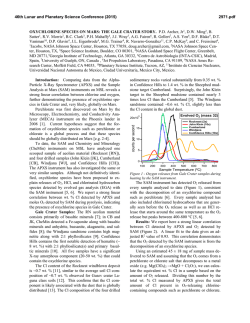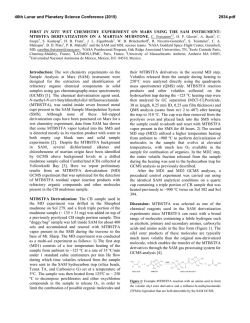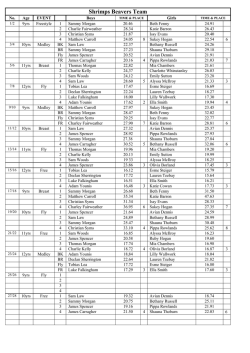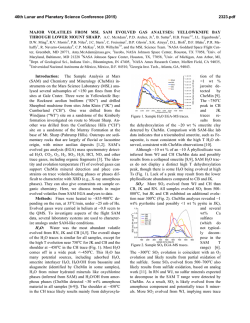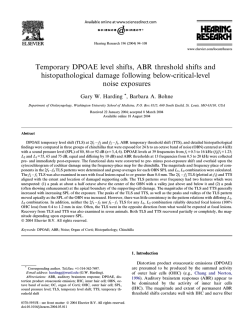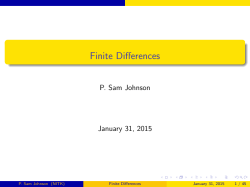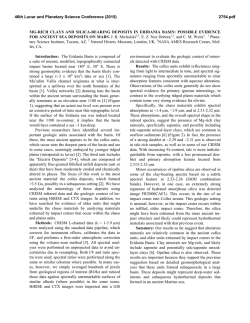
SELECT MSL SAMPLE ANALYSIS AT MARS (SAM) - USRA
46th Lunar and Planetary Science Conference (2015) 2558.pdf SELECT MSL SAMPLE ANALYSIS AT MARS (SAM) TESTBED ANALOG STUDIES. C. A. Malespin1,2, A. C. McAdam1, J. C. Stern1, C. Webster3, G. Flesch3, D. P. Glavin1, P. R. Mahaffy1, S. Teinturier1,2, C. Freissinet1, B. Prats1, M. Johnson1, E. Raaen1, D. P. Archer4, J. Eigenbrode1, and H. Franz1 1NASA Goddard Space Flight Center, Code 699, Greenbelt, MD, 20771 [email protected] , 2Goddard Earth Science Technology and Research, Universites Space Research Association, Columbia, MD, 3NASA Jet Propulsion Lab, Pasadena, CA 91109, 4 Jacobs, NASA Johnson Space Flight Center, Houston, TX 77058 Introduction: The Sample Analysis at Mars (SAM) Testbed (TB) instrument suite is a duplicate of the Flight (FM) version currently onboard the Curiosity rover in Gale Crater, Mars. A detailed description of the SAM instrument can be found in [1]. The TB is operated in the NASA Goddard Space Flight Center Mars environmental chamber, Figure 1, which was designed to replicate the thermal and atmospheric conditions at Gale Crater. The primary use of the TB is to develop and validate new and modified experimental procedures to be used on the FM. TB experiments are performed multiple times to ensure safe operation on Mars, as well as to optimize parameters for maximum science return. The TB is also used to analyze Mars analog materials under conditions as similar to those in the SAM FM runs as possible. Mars analog samples are first analyzed using one or more benchtop laboratory systems configured to run under SAM-like conditions. The results of these experiments allow the SAM team to narrow down which samples will be analyzed in the more resource intenstive SAM Testbed, the highest fidelity SAM-like system. These TB analog sample runs may have science or calibration (e.g., sample temperature calibration) rationales. maximum sample temperature of ~900°C, under an He carrier gas flowing at ~0.8 sccm. These conditions result in pressures of ~25 mb in the sample pyrolysis oven. Evolved volatiles can be detected by their massto-charge ratio (m/z) by the mass spectrometer (EGA mode), and can also be directed over a hydrocarbon trap for later analysis in gas chromatography mass spectrometry (GCMS) mode, or directed into the tunable laser spectrometer (TLS) for isotopic analysis. SAM experimental details and methods used are described in further detail in [1,3]. One difference of note between the TB and FM instruments is that the TB TLS exhibits more optical fringes than the FM unit, which reduces its precision and accuracy compared to the FM. Griffith Fe-saponite analog: Griffith saponite is thought to be a close terrestrial analog to the smectite clay mineral detected in the Sheepbed mudstone by the MSL CheMin and SAM instruments [e.g. 4,5]. A 10.2 mg sample of Griffith saponite was loaded into the SAM TB for analysis. H2O evolution during the run is illustrated in Figure 2, which shows the m/z 17 EGA trace. Isotopic composition (δD and δ18O) of the high temperature H2O, which results from dehydroxylation of the smectite, were obtained using the TLS. The TLS was given a temperature “cut” of the gas evolved from 600° C to 900° C during the pyrolysis ramp. TLS measured a δD of -104 ± 88‰, similar to values obtained by IRMS(Table 1). Figure 1. SAM TB inside the Mars environment chamber at NASA GSFC. The chamber was used for both FM and TB verification and testing. Preliminary results from three analog samples of interest are presented here: a griffith saponite clay mineral sample, a SAM calcite calibration cup, and a mixture of Fe3+ oxalate hexahydrate [2] and a NIST calcite isotope standard. Methods: The TB uses the same quartz cups found in the FM, but for ease of sample loading and removal, samples are loaded into a smaller nickel cup which is placed inside the TB quartz cup. Samples are then heated up using a ramp rate of 35°C/minute to a Figure 2. EGA trace illustrating the H2O evolved from a Griffith saponite sample analyzed on the SAM Testbed. The highest temperature H2O peak, occurring at ~730 °C, is the result of dehydroxylation of the smectite. Calibration Calcite cup: Calibration cups are loaded in both the FM and TB as described in [1]. The- 46th Lunar and Planetary Science Conference (2015) se cups contain both inorganic (calcite) and organic carbon-bearing materials, and are used to calibrate the evolution temperatures and abundances of CO2 and other mass fragments associated with organics. The cups are punctured in situ and run in EGA-GCMS-TLS mode with a low temperature cut of 20° - 200° C sent to the hydrocarbon trap for GCMS, and the gas from the remainder of the temperature ramp sent to the TLS. Two cups with 3.6 mg and 3.7 mg calcite, respectively, mixed into 121.6 mg fused silica and spiked with 5.1 nmol each of 3-fluorophenanthrene (3-FP) and 1-fluoronapthelene (1-FN) were run on the SAM TB. The evolved CO2 peaks for both samples are shown in Figure 3. The thermal decomposition of the calcite is clearly seen in both samples, resulting in the ~750 °C peak in the m/z 45 trace (the m/z 45 signal from the 13CO2 isotopologue is plotted instead of the main mass of CO2 because the m/z 44 signal is saturated). TLS measured δ13C of -25 ± 10‰, which is comparable to the value of -16.5‰ obtained by ground isotope ratio mass spectrometer (IRMS) analysis (Table 1). These TB results can be used as a reference for runs of the calcite calibration standard on the FM to be performed in the near future. 2558.pdf ty, SAM-like systems. The peaks near 200 °C and 400 °C result from the oxalate and the peaks near 700 °C result from the calcite. The CO2/CO ratio resulting from the oxalate decarboxylation near 400° C differs from that for the ~700 °C peak resulting from calcite thermal decomposition. Figure 4. EGA m/z 29 and 45 traces, illustrating the signal from the 13 CO and 13CO2 isotopologues respectively. The TLS cut aimed to capture the high temperature gas release from the NIST calcite. Summary: The TB is a high fidelity replica of the FM, which provides insight to the FM data and can be calibrated to well understood reference materials. SAM TB TLS and EGA data agree well with runs on other SAM-like laboratory systems or other ground truth measurements,,as shown in Table 1 for TLS data. A larger set of analog data will be reported in a future manuscript. Sample (gas) Figure 3. m/z 45 traces for two SAM Testbed EGA analyses of calcite showing the CO2 evolved during calcite decomposition. Blue is 3.6 mg, red is 3.7 mg calcite sample thermal NIST calcite standard and Fe3+ oxalate mixture: A mixture of 1.99 mg of NBS-19 carbonate NIST isotope standard and 2.4 mg of Fe3+ oxalate hexahydrate was run on the TB in EGA mode with a 650-950° C TLS cut for isotopic analysis. The TLS cut targeted capture of the CO2 from the calcite, while avoiding CO2 from the oxalate thermal decomposition. TLS provides a δ13C value of -18 ± 5‰, and a δ18O value of 20 ± 6‰, which compares to the NIST δ13C value of 1.95‰ and δ18O of 28.7‰ (Table 1). EGA CO (m/z 29) and CO2 (m/z 45) traces are shown in Figure 4. The peaks in these traces occur at the temperatures expected for thermal decomposition of these materials based on runs on other, lower fideli- SAM calcite (CO2) NBS19 calcite (CO2) Griffith saponite (H2O) TLS IRMS TLS IRMS δ13CVPDB -25 ± 10 δ13CVPDB -16.5± 0.3 δ18OVSMOW -11 ± 8 δ18OVSMOW 10.1 ± 0.4 -18 ± 5 1.95 (NIST) 20 ± 6 28.7 (NIST) δDVSMOW -104 ± 88 δDVSMOW -118 ± 1 δ18OVSMOW 18 ± 26 δ18OVSMOW TBD Table 1. Summary of preliminary TLS isotope ratio measurements in evolved CO2 and H2O compared to IRMS lab measurements. The quoted errors are 2 standard error from the mean (2SEM). References: [1] Mahaffy, P.R. et al (2012) Space Sci Rev. 170, 401-478. [2] Eigenbrode, E. L. et al. (2014) LPSC XLV [3] Glavin, D. et al. (2013) JGR, 118, 1955-1973. [4] Trieman et al (2014) Am. Min., 99, 1112, 2234-2250. [5] McAdam et al. (2014), in prep. Acknowledgments We thank the SAM science and operations teams.
© Copyright 2025
